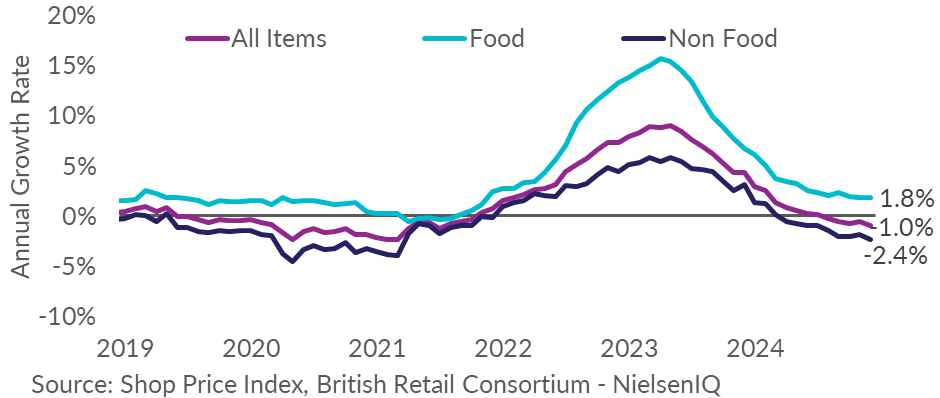The later timing of Black Friday in 2024 meant that 1-7
December data period included the final days of the Black Friday
discounting period (including Cyber Monday), while the Black
Friday discounting period had passed by December 2023. This means
Non-food prices are likely to appear more deflationary than the
underlying trend.
Period Covered: 01
– 07 December 2024
- Shop Price deflation was 1.0% in December, up from deflation
of 0.6% in the previous month. This is slightly above the 3-month
average rate of -0.8%. Shop price annual growth remained at its
lowest rate since August 2021.
- Non-Food remained in deflation at -2.4% in December, edging
down from -1.8% in the preceding month. This is below the 3-month
average rate of -2.1%. Deflation is its most since April 2021.
- Food inflation was unchanged at 1.8% in December. This is in
line with the 3-month average rate of 1.8%. The annual rate has
eased considerably since the start of the year and inflation
remained at its lowest rate since December 2021.
- Fresh Food inflation was unchanged in December, at 1.2%. This
is slightly above the 3-month average rate of 1.1%. Inflation was
its lowest since November 2021.
- Ambient Food inflation edged up to 2.8% in December, from
2.7% in November. This is in line with the 3-month average rate
of 2.8% and remained at its lowest since February 2022.
|
|
OVERALL SPI
|
FOOD
|
NON-FOOD
|
|
% Change
|
On last year
|
On last month
|
On last year
|
On last month
|
On last year
|
On last month
|
|
Dec-24
|
-1.0
|
0.0
|
1.8
|
0.1
|
-2.4
|
-0.1
|
|
Nov-24
|
-0.6
|
0.2
|
1.8
|
0.3
|
-1.8
|
0.2
|
Note: Month-on-month % change refers to changes in the
level of prices.

Helen Dickinson, Chief Executive of the BRC,
said:
“Retailers discounted heavily for Black Friday this year as they
attempted to make up for weaker sales earlier in the year.
However, the later Black Friday timing brought many of the
non-food discounts into the measurement period, making non-food
prices look more deflationary than the underlying trend. With
food inflation bottoming out at 1.8%, and many price pressures on
the horizon, shop price deflation is likely to become a thing of
the past.
“As retailers battle the £7 billion of increased costs in 2025
from the Budget, including higher employer NI, National Living
Wage, and new packaging levies, there is little hope of prices
going anywhere but up. Modelling by the BRC and retail CFOs
suggest food prices will rise by an average of 4.2% in the latter
half of the year, while Non-food will return firmly to inflation.
Government can still take steps to mitigate these price
pressures, and it must ensure that its proposed reforms to
business rates do not result in any stores paying more in rates
than they do already.”
Mike Watkins, Head of Retailer and Business Insight,
NielsenIQ, said:
“During December, shoppers benefited from both lower inflation
than last year and bigger discounts as both food and non-food
retailers were keen to drive sales after a slow start to the
quarter. However, higher household costs are unlikely to
dissipate anytime soon so retailers will need to carefully manage
any inflationary pressure in the months ahead.”
